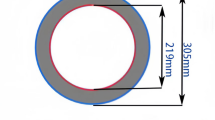Abstract
Prestressed concrete (PSC) bridge resists to deflection and cracking by prestressing its concrete superstructure using steel strands. The initial prestress force introduced in the strands at the completion of the structure influences sensitively its long-term performance. Rating the health of the PSC bridge should thus start with the knowledge of this initial prestress. However, the measurements given by the hydraulic jack and load cell used during prestressing may not be absolute indicators of the effective stress introduced in the strands. Considering that the strain distribution in the anchor can be used to measure the prestress in the strands and that the anchor head is the most accessible part of the PSC member, this study presents a method using the deformation characteristics of the anchor head to evaluate the initial prestress of the strands. To that goal, experimental and numerical analyses were performed on an anchorage-strand system considering the coefficient of friction between the wedge and the anchor head. The results show that the variation of the hoop strain measured in the multi-strand anchor head can be used to evaluate effectively the initial prestress state of the strands with respect to the applied jacking force.
Similar content being viewed by others
References
Abdullah, A. B. M., Rice, J. A., and Hamilton, H. R. (2014). “Wire breakage detection using relative strain variation in unbonded posttensioning anchors.” J Bridge Eng, Vol. 20, No. 1, 04014056.
Abdullah, A. B. M., Rice, J. A., and Hamilton, H. R. (2016). “A strainbased wire breakage identification algorithm for unbonded PT tendons.” Smart Struct Syst, Vol. 16, No. 3, pp. 415–433.
Al-Mayah, A., Soudki, K., and Plumtree, A. (2001). “Experimental and analytical investigation of a stainless steel anchorage for CFRP prestressing tendons.” PCI Journal, Vol. 46, No. 2, pp. 88–100.
Al-Mayah, A., Soudki, K., and Plumtree, A. (2006). “Development and assessment of a new CFRP rod-anchor system for prestressed concrete.” Appl Compos Mater, Vol. 13, No. 5, pp. 321–334.
Al-Mayah, A., Soudki, K. and Plumtree, A. (2007). “Novel anchor system for CFRP rod: Finite-element and mathematical models.” J Compos Constr, Vol. 11, No. 5, pp. 469–476.
Al-Mayah, A., Soudki, K., and Plumtree, A. (2008). “Effect of rod profile and strength on the contact behavior of CFRP-metal couples.” Compos Struct, Vol. 82, pp. 19–27.
Bastien, J., Marceau, D., Fafard, M., and Ganz, H. R. (2007). “Use of FEA for design of post-tensioning anchor head.” J. Bridge Eng, Vol. 12, pp. 194–204.
Chaki, S. and Bourse, G. (2009). “Guided ultrasonic waves for nondestructive monitoring of the stress levels in prestressed steel strands.” Ultrasonics, Vol. 49, No. 2, pp. 162–171.
Hewson, N. R. (2003). Prestressed concrete bridges: Design and construction, London: Thomas Telford Publishing.
Joh, C., Lee, J. W., and Kwahk, I. (2013). “Feasibility study of stress measurement in prestressing tendons using Villari effect and induced magnetic field.” International Journal of Distributed Sensor Networks, Article ID 249829, http://dx.doi.org/10.1155/2013/ 249829.
Kim, J. M., Kim, H. W., Choi, S. Y., and Park, S. Y. (2016). “Measurement of prestressing force in pretensioned UHPC deck using a fiber optic FBG sensor embedded in a 7-wire strand.” J. Sensors, http:// dx.doi.org/10.1155/2016/8634080.
Kim, S. T., Cho, J. R., Cho, K., Park, S. Y., and Park, Y. H. (2014). “Deformation characteristics of mono-strand anchor head.” Engineering, Vol. 6, pp. 743–749.
Korea Institute of Construction Technology (KICT). (2013). Development of smart prestressing and monitoring technologies for prestress concrete bridge. Research Report, KICT 2013-167.
Liu, X., Wu, B., Qin, F., He, C., and Han, Q. (2017). “Observation of ultrasonic guided wave propagation behaviours in pre-stressed multi-wire structures.” Ultrasonics, Vol. 73, pp. 196–205.
Marceau, D., Bastien, J., and Fafard, M. (2001). “Experimental and numerical studies of mono-strand anchorage.” Struct Eng Mech, Vol. 12, No. 2, pp. 119–134.
Noh, M. H., Seong, T. R., and Kim, J. K. (2012). “Nonlinear analysis of anchor head for high strength steel strand.” Journal of Computational Structural Engineering COSEIK, Vol. 25, No. 2, pp. 163–173.
Park, J. H., Yang, H. J., and Cho, J. R. (2014). “Numerical analysis for the deformation of a mono tendon anchor head.” Journal of the Korean Society of Safety, Vol. 29, No. 1, pp. 25–30.
Salamone, S., Bartoli, I., Phillips, R., Nucera, C., and Scalea, F. L. (2011). “Health monitoring of prestressing tendons in post-tensioned concrete bridges.” Journal of the Transportation Research Board, Vol. 2220, pp. 21–27.
Sayed-Ahmed, E. Y. and Shrive, N. G. (1998). “A new steel anchorage system for posttensioning applications using carbon fibre reinforced plastic tendons.” Can J Civ Eng, Vol. 25, pp. 113–127.
Seo, J. W., Jeong, W., Cho, E. K., and Yoo, H. (2010). “Parametric analysis to determine optimum geometries of PPWS sockets in cablesuspension bridges.” In: Proceedings of Steel Structure, Korean Society of Steel Construction, pp. 35–36.
Shimizu, T. and Sano, T. (1997). “Development of a penalty method contact algorithm and its application to a sheet forming problem.” J. Mater Process Tech, Vol. 67, pp. 177–182.
Tadros, M. N., Omaishi, N. A., Seguirant, S. J., and Gallt, J. G. (2001). Prestress losses in pretensioned high-strength concrete bridge girders, Transportation Research Board, NCHRP Report 496.
Vulovic, S., Zivkovic, M., Grujovic, N., and Slavkovic, R. (2007). “A comparative study of contact problems solution based on the penalty and Lagrange multiplier approaches.” J. Serb Soc Comp Mech, Vol. 1, No. 1, pp. 174–183.
Woodward, R. J. and Williams, F. W. (1988). “Collapse of Ynys-y-Gwas Bridge, West Glamorgan.” ICE Proceedings, Vol. 84, No. 4, pp. 635–669.
You, Y. J., Park, K. T., and Lee, K. W. (2011). “Experimental study on smart anchor head.” World Academy of Science, Engineering and Technology, Vol. 5, pp. 603–607.
Author information
Authors and Affiliations
Corresponding author
Rights and permissions
About this article
Cite this article
Park, J.H., Cho, JR. & Choo, J.F. Evaluation of initial prestress state in PS strand using the deformation characteristics of multi-strand anchor head. KSCE J Civ Eng 22, 647–656 (2018). https://doi.org/10.1007/s12205-017-0800-x
Received:
Revised:
Accepted:
Published:
Issue Date:
DOI: https://doi.org/10.1007/s12205-017-0800-x




